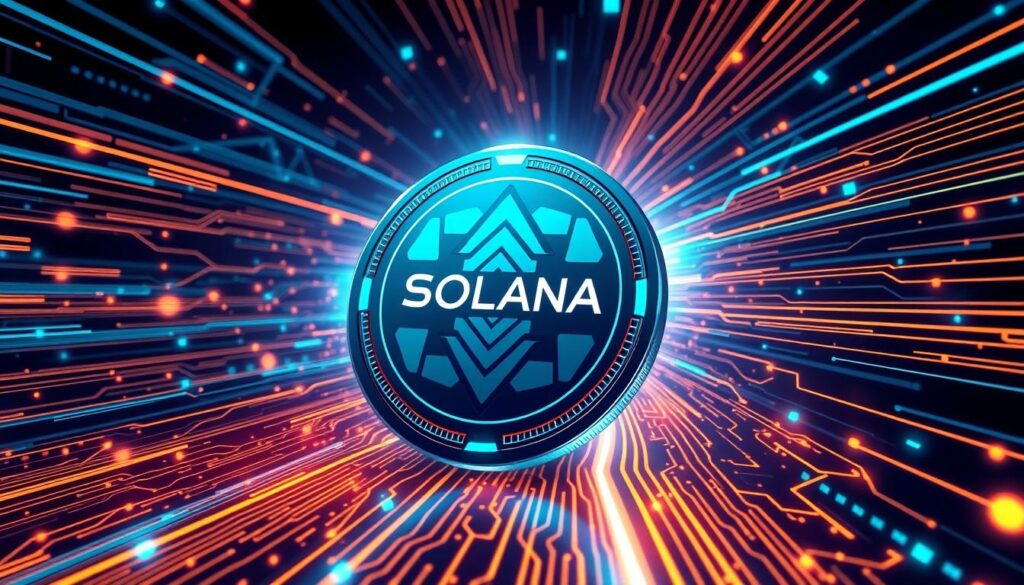Now Reading: Solana (SOL): The Fast, Scalable Blockchain Solution
- 01
Solana (SOL): The Fast, Scalable Blockchain Solution
Solana (SOL): The Fast, Scalable Blockchain Solution

In the rapidly evolving world of cryptocurrencies and decentralized applications, Solana (SOL) has emerged as a game-changer, offering a blockchain solution that is both lightning-fast and highly scalable. Designed to address the challenges of traditional blockchain platforms, Solana’s innovative approach has caught the attention of developers, investors, and the broader Web3 ecosystem.
Solana’s unique features, such as its proof-of-history consensus mechanism and its ability to achieve high throughput and low latency, have positioned it as a leading contender in the race to build the infrastructure for the decentralized future. With its growing ecosystem of decentralized finance (DeFi) applications, non-fungible tokens (NFTs), and other Web3 initiatives, Solana is poised to play a crucial role in shaping the next generation of blockchain-powered technologies.
Key Takeaways
- Solana (SOL) is a high-performance blockchain that offers lightning-fast transaction times and low fees.
- Solana’s innovative consensus mechanism, proof-of-history, and parallel transaction processing (Sealevel) enable it to achieve exceptional scalability.
- The Solana ecosystem is rapidly growing, with a strong focus on decentralized applications (dApps), DeFi, and NFTs.
- Solana aims to address the “blockchain trilemma” of scalability, security, and decentralization, positioning itself as a leading platform for Web3 development.
- Solana has gained significant attention and adoption, making it one of the largest cryptocurrencies by market capitalization.
What is Solana (SOL)?
Solana is a revolutionary blockchain network that is powering the next generation of decentralized applications (dApps). Built on the innovative Proof-of-History (PoH) consensus mechanism, Solana offers high-performance and low-fees, making it a leading contender in the world of blockchain technology.
Introduction to the Solana Blockchain
Launched in 2020, the Solana blockchain is an open-source, permissionless platform designed to address the scalability challenges plaguing traditional blockchain networks. By utilizing the PoH consensus mechanism, Solana is able to achieve unprecedented transaction speeds and throughput, far surpassing the capabilities of other popular Solana (SOL) protocols.
Key Features of Solana
- High-Performance: Solana is capable of processing over 50,000 transactions per second, making it one of the fastest blockchain networks in the world.
- Low Fees: Transactions on the Solana network incur low-fees, ensuring that dApp developers and users can benefit from the blockchain’s efficiency.
- Scalability: Solana’s unique architecture allows for horizontal scaling, enabling the network to grow and accommodate increasing user demand without sacrificing performance.
- Developer-Friendly: Solana offers a robust ecosystem and comprehensive toolset, making it an attractive platform for developers to build and deploy their Solana (SOL) dApps.
By combining these innovative features, Solana is positioned to play a pivotal role in the blockchain industry, revolutionizing the way we interact with decentralized applications and services.
Proof-of-History: Solana’s Innovative Consensus Mechanism
At the heart of the Solana (SOL) blockchain lies its innovative Proof-of-History (PoH) consensus mechanism. Unlike traditional consensus protocols, PoH introduces a unique approach to verifying the passage of time between events, enabling Solana to achieve remarkable scalability and efficiency.
Proof-of-History is a cryptographic clock that records the time between events, eliminating the need for validators to reach consensus on the order of transactions. This groundbreaking concept allows Solana to process transactions in parallel, dramatically increasing throughput and reducing latency.
The key to Solana’s Proof-of-History is its ability to establish a secure, verifiable, and tamper-proof record of the passage of time. By generating a unique hash for each event and incorporating it into the subsequent hash, the system creates a continuously evolving timeline that validators can quickly verify and validate without the traditional consensus-building process.
“Proof-of-History is a breakthrough innovation that sets Solana apart from other blockchain networks, enabling it to deliver unparalleled performance and scalability.”
This innovative consensus mechanism is a crucial component of Solana’s architecture, allowing the network to overcome the blockchain trilemma and provide a fast, secure, and highly scalable platform for decentralized applications (dApps).
Unlocking Scalability with Proof-of-History
Solana’s Proof-of-History consensus mechanism is a game-changer in the world of blockchain technology. By eliminating the need for validators to reach consensus on the order of transactions, Solana can achieve unparalleled scalability and performance, processing thousands of transactions per second with minimal latency.
This innovative approach to consensus not only enhances Solana’s overall efficiency but also paves the way for a new era of decentralized applications (dApps) that can thrive on a fast, secure, and scalable blockchain network.
Scalability: Solving the Blockchain Trilemma
The Solana blockchain has been designed to address the fundamental challenge of the blockchain trilemma – the delicate balance between decentralization, security, and scalability. By leveraging its innovative Proof-of-History consensus mechanism and Sealevel parallelism, Solana has achieved a remarkable level of scalability, setting it apart from many other blockchain platforms.
High Throughput and Low Latency
Solana’s Proof-of-History consensus protocol enables the network to process transactions at lightning-fast speeds, with a throughput capacity of up to 65,000 transactions per second (TPS) and an average block time of just 400 milliseconds. This high-throughput and low-latency performance is a game-changer, allowing Solana (SOL) to facilitate the seamless execution of a wide range of decentralized applications (DApps) and financial services without compromising the user experience.
Horizontal Scaling with Sealevel Parallelism
One of the key innovations that sets Solana apart is its Sealevel parallelism, which enables the network to scale horizontally. This groundbreaking approach allows Solana to process multiple transactions simultaneously, rather than sequentially, unleashing unprecedented levels of scalability. By harnessing the power of parallel processing, Solana can effectively address the Blockchain Trilemma and deliver a highly scalable blockchain solution that can keep pace with the growing demands of the decentralized ecosystem.
| Feature | Solana | Ethereum | Bitcoin |
|---|---|---|---|
| Transactions per second (TPS) | 65,000 | 30 | 7 |
| Consensus Mechanism | Proof-of-History | Proof-of-Work | Proof-of-Work |
| Sealevel Parallelism | Yes | No | No |
“Solana’s unique architecture, with its Proof-of-History consensus and Sealevel parallelism, has the potential to revolutionize the blockchain industry by delivering unprecedented levels of scalability without sacrificing decentralization or security.”
Solana (SOL): The Native Cryptocurrency
Solana, the innovative blockchain network, has its own native cryptocurrency called SOL. This digital token powers the Solana ecosystem and serves various critical functions within the network.
SOL Token Utility and Economics
The SOL token is the lifeblood of the Solana blockchain, enabling a wide range of use cases. Some of the key utilities of the SOL token include:
- Paying transaction fees on the Solana network
- Staking SOL to participate in the consensus mechanism and earn rewards
- Rewarding validators who contribute to the network’s security and stability
- Facilitating the usage of decentralized applications (DApps) built on Solana
The Solana token economics are designed to incentivize network participation and security. The total supply of SOL tokens is capped at 489 million, with a portion of the tokens allocated to the Solana Foundation, developers, and early investors. The remaining SOL tokens are distributed through a combination of staking rewards and new token issuance, ensuring a sustainable and decentralized ecosystem.

By leveraging the inherent properties of the Solana blockchain, such as its fast transaction times and low fees, the SOL token aims to provide a user-friendly and scalable cryptocurrency experience for both individual and institutional users.
Decentralized Applications (DApps) on Solana
The Solana blockchain has emerged as a leading platform for building innovative decentralized applications (DApps) across various domains, particularly in the realms of decentralized finance (DeFi), non-fungible tokens (NFTs), and the broader Web3 ecosystem. Solana’s high-performance and low-cost infrastructure have made it an attractive choice for developers seeking to create scalable and user-friendly DApps.
DeFi on Solana
Solana’s DeFi ecosystem has seen rapid growth, with a wide range of DApps catering to different financial services, including lending, borrowing, trading, and yield farming. The blockchain’s fast transaction times and low fees have enabled the development of DeFi platforms that can compete with traditional financial institutions in terms of speed and efficiency.
NFTs and the Solana Ecosystem
Solana has also become a prominent destination for the thriving NFT market. The blockchain’s ability to handle high-volume transactions has allowed for the creation of NFT marketplaces, gaming platforms, and digital art collections that can provide a seamless user experience. Solana’s vibrant NFT ecosystem has attracted a diverse range of creators, collectors, and enthusiasts.
Building the Web3 Future on Solana
Beyond DeFi and NFTs, Solana has become a hub for the development of a wide range of Web3 applications, from decentralized social media platforms to decentralized storage solutions. The blockchain’s scalability and low fees have enabled developers to build DApps that can cater to the needs of mainstream users, driving the adoption of Web3 technologies.
As Solana continues to attract a growing community of developers, the blockchain’s DApp ecosystem is expected to expand further, driving innovation and adoption across various industries and use cases.
Solana’s Performance: Benchmarks and Comparisons
Solana (SOL), the innovative blockchain network, has repeatedly demonstrated its impressive performance capabilities. One of the key metrics that showcases Solana’s superiority is its ability to process over 65,000 transactions per second (TPS), a figure that outpaces many of its competitors in the blockchain space.
Furthermore, Solana achieves block times of around 400 milliseconds, underscoring its exceptional speed and efficiency. This positioning Solana as one of the fastest and most scalable blockchain networks available today.
| Metric | Solana | Ethereum | Bitcoin |
|---|---|---|---|
| Transactions per Second (TPS) | 65,000+ | 30 | 7 |
| Block Time | 400 ms | 13 s | 10 min |
| Consensus Mechanism | Proof-of-History | Proof-of-Work | Proof-of-Work |
The table above provides a direct comparison of key performance metrics between Solana, Ethereum, and Bitcoin, clearly showcasing Solana’s superior throughput and latency.
These impressive Solana benchmarks have positioned the network as a leading contender in the race for blockchain supremacy, with its ability to deliver high-speed, scalable, and efficient transactions that can cater to the demands of the modern digital economy.

Solana’s Ecosystem and Community
Solana, the fast and scalable blockchain, has built a thriving Solana (SOL) ecosystem that includes a diverse array of developers, projects, and partnerships. The Solana (SOL) community has been instrumental in driving the platform’s growth and adoption, fostering innovation and collaboration across the Web3 landscape.
Developers and Projects
The Solana (SOL) ecosystem is home to a rapidly expanding community of developers who are building a wide range of decentralized applications (DApps), DeFi protocols, NFT marketplaces, and other cutting-edge Web3 initiatives. These projects leverage Solana’s lightning-fast transaction speeds, low fees, and scalable architecture to deliver seamless user experiences and drive the adoption of blockchain technology.
| Project | Category | Description |
|---|---|---|
| Serum | DeFi | A decentralized exchange (DEX) built on Solana, offering fast and low-cost trading. |
| Metaplex | NFTs | A platform for creating, distributing, and managing Solana (SOL)-based non-fungible tokens (NFTs). |
| Solana Pay | Payments | A decentralized payment protocol that enables fast and secure Solana (SOL) transactions. |
These are just a few examples of the thriving Solana (SOL) ecosystem, which continues to expand with new and innovative projects that push the boundaries of blockchain technology.
Partnerships and Collaborations
Solana (SOL) has also forged strategic partnerships with leading companies and organizations, further expanding its reach and adoption. These collaborations have brought together industry experts, technology providers, and ecosystem participants to drive the development and integration of Solana (SOL)-based solutions across various sectors.
- Solana partnered with Stripe, a global leader in online payments, to enable seamless Solana (SOL) payments for merchants and consumers.
- The Solana (SOL) community has collaborated with major Web3 platforms like Phantom, a popular Solana (SOL) wallet, to enhance the user experience and drive broader adoption.
- Solana has also established partnerships with leading NFT platforms, such as Magic Eden, to foster the growth of the Solana (SOL) NFT ecosystem.
These strategic partnerships and collaborations have been instrumental in expanding the reach and impact of the Solana (SOL) ecosystem, driving innovation and fostering a vibrant community of developers, projects, and users.
Challenges and Criticisms of Solana
As the Solana (SOL) blockchain has gained significant traction, it has also faced a number of challenges and criticisms. One key concern is the network’s susceptibility to outages, which have disrupted its operations on several occasions. The Solana community has been working to address these reliability issues and improve the network’s overall stability.
Another criticism of Solana (SOL) is the perceived centralization of its validator network. While the blockchain aims to maintain a decentralized architecture, the concentration of power among a relatively small number of validators has raised concerns about the network’s true decentralization. The Solana team is actively exploring ways to further decentralize the validator network and promote greater participation from the broader community.
Additionally, there have been some questions raised about the security and potential vulnerabilities of Solana’s innovative Proof-of-History consensus mechanism. While the mechanism offers significant performance advantages, it is a relatively new and untested approach compared to more established consensus models like Proof-of-Work or Proof-of-Stake. The Solana team is working to address these concerns and continuously enhance the security and resilience of the Blockchain network.
FAQ
What is Solana (SOL)?
Solana is a high-performance blockchain that is designed to be scalable, secure, and efficient. It utilizes a novel consensus mechanism called Proof-of-History (PoH) to achieve fast transaction times and low fees, making it an attractive platform for building decentralized applications (dApps).
What is Proof-of-History (PoH)?
Proof-of-History (PoH) is Solana’s innovative consensus mechanism that involves a cryptographic clock to record the passage of time between events. This allows Solana to process transactions in parallel without the need for validators to reach consensus on the order of events, resulting in high throughput and low latency.
How does Solana address the blockchain scalability challenge?
Solana’s design and consensus mechanism enable it to address the blockchain trilemma – the challenge of achieving decentralization, security, and scalability simultaneously. Solana’s high throughput and low latency are achieved through its Proof-of-History consensus and Sealevel parallelism, which allows for the parallel processing of transactions, unlocking unprecedented scalability.
What is the utility of the SOL token?
Solana’s native cryptocurrency, SOL, powers the Solana blockchain and its ecosystem. The SOL token is used for paying transaction fees, staking to participate in consensus, and rewarding validators. The Solana token economics are designed to incentivize network security and participation.
What kind of decentralized applications (dApps) are being built on Solana?
Solana has emerged as a leading blockchain for building decentralized applications (dApps), particularly in the areas of decentralized finance (DeFi), non-fungible tokens (NFTs), and the broader Web3 ecosystem. The Solana blockchain’s high performance and low fees make it an attractive platform for developers to build innovative dApps that can scale and provide a seamless user experience.
How does Solana’s performance compare to other blockchains?
Solana has demonstrated impressive performance benchmarks, with the ability to process over 65,000 transactions per second (TPS) and achieve block times of around 400 milliseconds. These figures position Solana as one of the fastest and most scalable blockchain networks, outperforming many of its competitors in terms of throughput and latency.
What is the Solana ecosystem and community like?
Solana has built a thriving ecosystem of developers, projects, and partnerships. The Solana ecosystem includes a growing number of decentralized applications, DeFi protocols, NFT marketplaces, and other Web3 initiatives. Solana has also forged strategic partnerships with leading companies and organizations, further expanding its reach and adoption.
What are some of the challenges and criticisms facing Solana?
While Solana has gained significant traction, it has also faced some challenges and criticisms. These include concerns over network outages, centralization of the validator network, and potential vulnerabilities in its consensus mechanism. Solana’s team and community are actively working to address these issues and further strengthen the network’s resilience and security.














